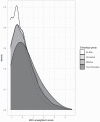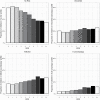Cumulative Environmental Risk in Early Life: Associations With Schizotypy in Childhood
- PMID: 36302227
- PMCID: PMC10016419
- DOI: 10.1093/schbul/sbac160
Cumulative Environmental Risk in Early Life: Associations With Schizotypy in Childhood
Abstract
Background and hypothesis: Psychotic disorders are associated with a growing number of recognized environmental exposures. Cumulative exposure to multiple environmental risk factors in childhood may contribute to the development of different patterns of schizotypy evident in early life. Hypotheses were that distinct profiles of schizotypy would have differential associations with a cumulative score of environmental risk factors.
Study design: We prospectively examined the relationship between 19 environmental exposures (which had demonstrated replicated associations with psychosis) measured from the prenatal period through to age 11 years, and 3 profiles of schizotypy in children (mean age = 11.9 years, n = 20 599) that have been established in population data from the New South Wales-Child Development Study. Multinomial logistic regression was used to examine associations between membership in each of 3 schizotypy profiles (true schizotypy, introverted schizotypy, and affective schizotypy) and exposure to a range of 19 environmental risk factors for psychosis (both individually and summed as a cumulative environmental risk score [ERS]), relative to children showing no risk.
Results: Almost all environmental factors were associated with at least 1 schizotypy profile. The cumulative ERS was most strongly associated with the true schizotypy profile (OR = 1.61, 95% CI = 1.52-1.70), followed by the affective (OR = 1.33, 95% CI = 1.28-1.38), and introverted (OR = 1.32, 95% CI = 1.28-1.37) schizotypy profiles.
Conclusions: Consistent with the cumulative risk hypothesis, results indicate that an increased number of risk exposures is associated with an increased likelihood of membership in the 3 schizotypy profiles identified in middle childhood, relative to children with no schizotypy profile.
Keywords: environment; latent profile analysis; psychosis; risk score; schizophrenia-spectrum disorders.
© The Author(s) 2022. Published by Oxford University Press on behalf of the Maryland Psychiatric Research Center. All rights reserved. For permissions, please email: journals.permissions@oup.com.
Figures
Comment in
-
Early Schizotypy and Risk: The Need for Integrating Developmental Dynamics.Schizophr Bull. 2023 Mar 15;49(2):234-236. doi: 10.1093/schbul/sbac161. Schizophr Bull. 2023. PMID: 36259928 Free PMC article. No abstract available.
References
-
- Claridge GE. Schizotypy: Implications for Illness and Health. Oxford, UK: Oxford University Press; 1997.
-
- Meehl PE. Schizotaxia, schizotypy, schizophrenia. Am Psychol. 1962;17(12):827827.–8278838.
-
- Meehl PE. Toward an integrated theory of schizotaxia, schizotypy, and schizophrenia. J Personal Disord. 1990;4(1):1–99.
Publication types
MeSH terms
LinkOut - more resources
Full Text Sources
Medical



